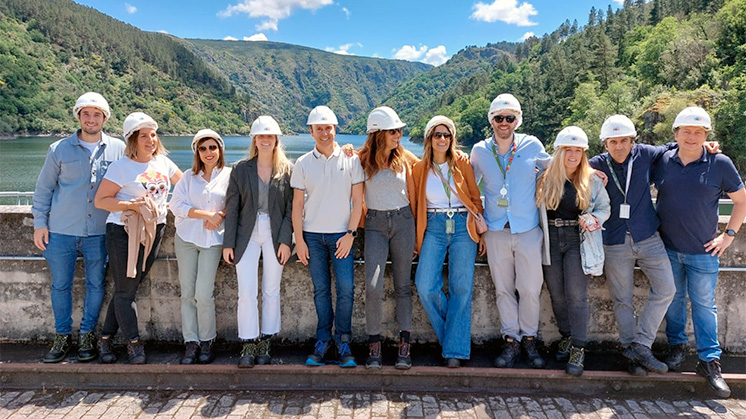Generational diversity
Understanding and leveraging generational diversity in the workplace
Employment Professional skills Youth
Four different generations coexist in today's labour market. Each of them has its own knowledge, experiences, values and languages that make them unique. Promoting inclusion and intergenerational dialogue and knowing how to manage this diversity in companies is crucial, both socially and strategically, to contribute to a pleasant and productive working environment.

May 2024

Approximately 12 minutes
The concept of diversity does not only refer to origin, skin colour, language, sexual identity or religious beliefs, but goes much further and is also related to age diversity. In a work environment, age diversity facilitates the combination of seniority and youth, experience and a fresh outlook.
This heterogeneity is particularly important in the current context. Our society is developing amidst disruptive changes such as the technological revolution, which is now taking a new turn with the advent of artificial intelligence. Intergenerational differences are increasing, as each of them is influenced by different realities and skills. This is the case, for example, of generation Z people, considered "digital natives", compared to previous age groups who adapted to this knowledge in their work, administrative tasks or even in their social circles.
But what does generational diversity really mean and what is its main threat? Which groups make up today's society? Is it possible to manage these differences efficiently in companies?
What is generational diversity?
The term ‘generational diversity’ refers to the presence of different age groups within a population, community or organisation —each with their own characteristics, experiences, perspectives and values—. When this heterogeneity is part of the workplace, it results in a workforce with people from different generations, which may be strategically sought or naturally developed over the history of that company.
We usually take the age diversity in families for granted and in many cases we are aware of the advantages of these intergenerational relationships, for example, in the knowledge and experience that grandchildren learn from grandparents. However, this diversity is not always present in other circles.
In an extreme case, we fail to take into account the experiences and needs of different generations and this invisibilisation can lead to ageism, i.e. discrimination or prejudice based on age – whether against younger or older people. This form of exclusion, which is similar to sexism or racism, involves stereotypes, prejudices and discrimination towards people of a certain generation.
In order to enhance age diversity, which more and more organisations and communities are advocating, it is essential to understand the different generations that make up our society and today's workforce.

Generations X, Y and Z
From the baby boomer to the post-millennial generations: 50 years of change

Generation Alpha
This generation comes to replace generation Z. We review its characteristics.

Silver economy
Older people will become the engine of the so-called silver economy.

Multicultural teams
We encourage the creation of teams with different cultures and locations.
Classification of generations
Currently, four different generations can be distinguished within the working population: 'baby boomers', 'Generation X', 'Generation Y' or 'millennials', and 'Generation Z' or 'centennials'. In the employment context, the main differences between them are their expected professional experience and their relationship with technology.
However, it should be borne in mind that each person is unique and that the characteristics for each generation are for guidance only. Each age group, depending on its time and circumstances, shares a social and working context, but this does not mean that all members of a generation behave or relate to their environment in the same way. Precisely being aware of this aspect allows us in a certain way to confront ageism by not accepting certain characteristics without first stopping to question them.
Baby Boomer Generation (1946-1964)
The end of World War II and the significant rise in birth rates that followed in many countries gave rise to this generation, which was born in good economic times. Many baby boomers are now retired or close to retirement age, but many are still in the labour market. They have more experience, as they have been working the longest. In general, this generation has progressively adapted to new technologies and have been considered 'digital immigrants'.
Generation X (1965-1979)
Generation X still grew up in a largely analogue age, although those born closer to the 1980s had their first contact with the emerging digital technology. In general, they adapted more easily than baby boomers to the advent of the Internet and its further development.
Millennial Generation (1980-1990)
Also known as members of 'generation Y'. There is no total consensus on the start and end years that define this group, but what they all have in common is that they all grew up in the midst of a technological revolution and digital connectivity.
Generation Z (1991-2010)
Members of this group are the youngest to enter the labour market. They are considered 'digital natives' as they grew up with digital technology from a very young age. They lived and live in an Internet society and most are at the forefront of social media, usually with extensive knowledge about youtubers, influencers or tiktokers.
Management of generational diversity
Until a few years ago, age diversity between workers in the same company was not taken into account as much. However, new human resources policies are increasingly sensitive to the different characteristics, needs and demands of each generation and tap into the skills of each stage of life and professional development.
This management of intergenerational diversity can be a major challenge for a company. Doing so successfully involves building teams with people of different ages and combining different skills and approaches that enrich the company and add value. This generational culture will lead to a mutually enriching symbiosis that will not only result in higher productivity, but will also have a positive impact on work motivation and employee well-being.
Some of the challenges that management teams need to work on in order to close the generation gaps may include:
- Work-life balance. Different generations may have different expectations in this regard. It is important to provide policies and actions that meet the needs of all employees, regardless of their age.
- Technology skills. It is essential to provide training and technological support and to facilitate knowledge sharing between different generations.
- Diversity of ways of working. Leaders should facilitate collaboration and communication between groups and their different ways of working and relating to each other.
- Intergenerational conflicts. It is important to foster an atmosphere of respect and understanding for the conflicts that may arise between employees of different ages due to their different expectations and views.
- Knowledge transfer. Businesses need to find ways to overcome the difficulties of transferring knowledge and skills from one generation to another.
- Prejudices and stereotypes. Raising awareness of these types of discrimination fosters an environment where the contributions of all employees are valued.
Generational diversity in the workplace
There are common themes that cut across all generations in a work environment. Companies can take advantage of these commonalities, as well as understand and consider the details that are characteristic of each group. A strict categorisation of priorities and interests by age can be detrimental and can encourage stereotyping.
Widespread myths about generational job preferences
Baby boomers
Generation X
Millennials
Some key facts
Advantages of generational diversity in companies
According to a study conducted by Harvard Business Review  , companies with diversity have 19% more innovation revenue. In fact, US consultancy firm Gartner
, companies with diversity have 19% more innovation revenue. In fact, US consultancy firm Gartner  estimates that diverse teams improve performance by up to 30% in highly diverse environments.
estimates that diverse teams improve performance by up to 30% in highly diverse environments.
Therefore, having a diverse workforce means that employees are happier and the company has greater access to the talent and skills they need for their organisations to thrive. Some of the most significant benefits of generational diversity in the workplace include:
Demographic developments in the countries where we operate
The generational composition of the workforce is a true reflection of a country's demographic pyramid. Most societies today are undergoing significant changes due to various factors, such as increasing life expectancy, low birth rates, migration or economic challenges.
The most developed countries among those in which we operate – Spain, the United Kingdom and the United States, with the exception of Australia – face a major problem of population ageing. For instance, Spain is experiencing a major demographic crisis with a highly ageing population, which threatens the sustainability of social security and pension systems. The UK is experiencing a similar situation and the proportion of older people is expected to increase in the coming years.
Mexico has a young and diverse population and Brazil's population is growing rapidly, with a relatively young age, although in recent years it has shown a slight ageing.
Intergenerational actions to manage diversity
Each company must find its own mechanisms to build age-friendly workplaces according to its own circumstances. Some basic guidelines include valuing the talent of employees or encouraging them to train in different skills.
It is essential to encourage teamwork, distribute responsibilities according to the professional stage of each employee’s career and avoid prejudices, biases or non-inclusive language. A positive idea is to organise mentoring sessions on different topics, so that staff or group members have the opportunity to share or learn certain knowledge.
We also have various internal initiatives to create employment opportunities for people of different ages and to promote their inclusion through training activities. One of the most noteworthy examples is Silver Experience, a programme promoted by Iberdrola España to foster intergenerational exchange, in which employees with more than 30 years of experience share their work experiences and knowledge with employees with less than five years of experience.
We also organise mentoring sessions to foster mutual learning, such as Avangrid's Engineering Development Program, which offers a two-year technical curriculum where young people work with mentors to accelerate their development; Neoenergia's Mentorías del Futuro, together with Joule Institute, where participants can prepare for the job market and receive guidance from an experienced mentor; or Iberdrola Mexico's Enlace Generacional affinity group, a space for shared knowledge between workers of different generations.




















